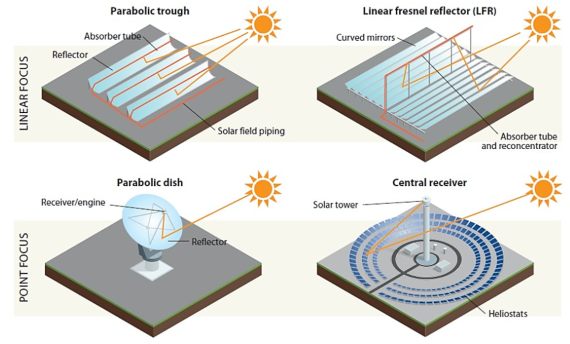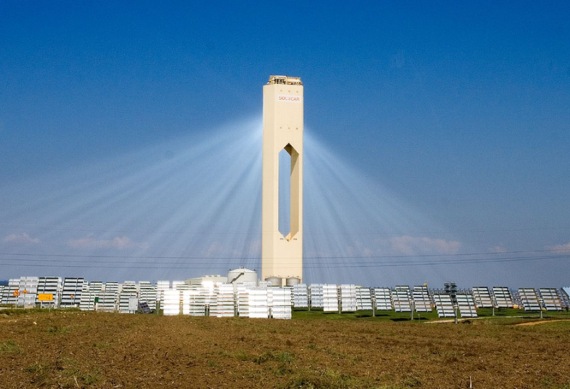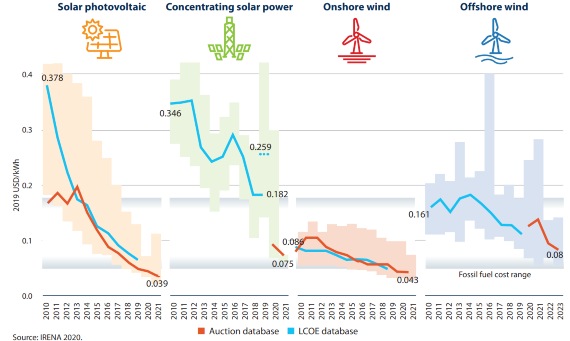Along with photovoltaic solar energy and wind energy, there is another renewable technology that takes advantage of our main energy resource, the sun, to produce electricity: solar thermoelectric, thermosolar or concentrated solar power. Its operating principle is based on the use of mirrors that concentrate the sun’s radiation to obtain steam, which is then directed towards the blades of a turbine to move them and thus produce electricity. In this sense, it is similar to fossil fuel or uranium-based technologies in that what it does is move the turbines of a generator, but without burning gas or fissioning uranium.
Known as Concentrating Solar Power (CSP), this technology’s ability to store the energy produced can provide flexible, renewable energy, 24 hours a day, 7 days a week, in regions with excellent direct solar resources. This article describes the main features of this technology.
BRIEF HISTORY OF CSP
The idea of using mirrors to concentrate solar radiation to heat a given object or fluid is not new. The Greek scientist Archimedes used the reflective properties of bronze shields to set fire to Roman ships besieging Syracuse in 212 B.C. during the Second Punic War. Although there are doubts about the veracity of this unique story, the experience has subsequently been successfully recreated, proving the effectiveness of concentrating sunlight to generate heat. The following image shows a painting from the Ufizzi gallery in Florence illustrating Archimedes’ alleged contraption:

Mural painting (Giulio Parigi, 1600) depicting the huge bronze mirror supposedly built by Archimedes to reflect the sun’s rays on the Roman ships besieging Syracuse to set them on fire. Stanzino delle Matematiche, Uffizi Gallery (Florence, Italy)
Despite the first modern commercial CSP plants being built in the 1980s, the technology has a long history dating back to the late 19th century, when it was used to power the first solar steam engine. Given the excellent solar resources found in the MENA region, it is not surprising that the first parabolic trough systems were installed there in 1912, near Cairo (Egypt). The system was designed to generate steam for a pump that supplied 2,000 m3/h of water for irrigation. It should be noted that even in 1912, CSP plant technology was regionally competitive with coal-fired steam generating facilities.

In the 1970s, when the United States became a net energy importer, President Richard M. Nixon created several research groups to examine the potential of new renewable technologies to make the United States energy independent again. In 1972, the Federal Council for Science and Technology concluded that the technologies for generating solar thermal power could provide 20% of the country’s energy needs by 2020. Given the prohibitive costs of solar photovoltaic technology at the time, it was assumed that all solar energy would be thermal. After the 1973 oil crisis, the U.S. federal CSP research budget tripled. But as oil prices fell in the 1980s, and Reagan-era budget cuts reduced research and development, the sector stagnated until the early 2000s.
At the beginning of this century, in Spain, following the publication of the famous Royal Decree 661/2007 generous premiums for electricity production encouraged developers to start up CSP projects, making Spain the world leader in this technology in terms of installed capacity 2,300 MW), a position it still holds today. Despite this, the deployment of new projects stagnated when these premiums were cut in 2008-2010, a situation that, as far as CSP technology is concerned, has not changed substantially since then.
Fundamentals of CSP plants
As mentioned above, CSP plants are based on the use of mirrors that concentrate direct radiation from the sun onto a receiver filled with a fluid, usually thermal oil or molten salts. This fluid, called heat transfer fluid, conducts heat to an exchanger where it is used to generate steam. The steam is then directed under pressure to a turbine to move its blades and produce electrical energy, following a procedure similar to that used in conventional thermal power plants. Broadly speaking, a CSP plant consists of three main units:
- Solar collectors, which are mirrors that reflect sunlight and concentrate it on a certain focus, converting solar energy into thermal energy.
- A means of heat storage by means of water vapor or molten salts.
- An electric power generator, which produces electricity via a turbine driven by steam that has been obtained from the conversion of solar radiation into heat.
CSP plants are of four main types: linear parabolic trough concentrators, Fresnel lens concentrators, tower concentrators and parabolic mirror concentrators (Stirling concentrators) Stirling concentrators). The following shows the four, the fundamentals of which are briefly described in the next paragraph:

The four types of solar thermal power plants from top to bottom and from left to right: Linear concentrators; Fresnel mirrors; parabolic mirror and tower concentrators
– Linear concentrators: their operation is based on capturing the sun’s energy using U-shaped curved rectangular mirrors directed towards the sun; they collect the light and concentrate it in tubes that run parallel along the mirrors, located on the focal line of the mirrors. The reflected sunlight heats a fluid that circulates through the tubes. This fluid is then used to produce steam in a conventional turbine generator that produces electricity.
– Fresnel mirrors: like the previous ones, the receiver tube is located above several mirrors that are positioned at different angles so that they all redirect the solar radiation towards the tube.
– Parabolic mirror: they make use of a circular mirror similar to the dishes used in satellite dishes for satellite television signals. The surface of the disk receives the sunlight and redirects it by concentrating it on a thermal receiver, which absorbs and collects the heat and transfers it to a piston engine, similar to the pistons of internal combustion engines. This system uses the fluid heated by the receiver to move the motor pistons and transform the heat energy into mechanical energy. Subsequently, the mechanical energy is used to drive a generator to produce electricity.

– Tower concentrators: they use a large field of flat mirrors called heliostats to focus and concentrate the sunlight on a receiver located on top of a tower (the image at the beginning of this article shows a field of these solar collectors). A fluid is heated in the receiver and used to generate steam which, in turn, is used in a conventional turbine generator to produce electricity. Some towers use water as the fluid, while other advanced designs are experimenting with molten nitrate salts due to their superior heat storage capabilities.
Pros and Cons of Concentrated Solar Power
In this article, I analyze the advantages and disadvantages of this technology in order to understand what factors hinder its massive roll-out. The following image shows a diagram of the essential components of a CSP plant that uses a concentrating tower.
Diagram of a CSP tower plant
PECULIARITIES OF CSP PLANTS
On paper, this technology has several benefits, but also some disadvantages. I analyze them below:
High energy efficiency
This factor – essential in any power plant – depends on several factors in the case of CSP: the reflective mirror’s capacity to concentrate solar radiation, the temperature that the transfer fluid reaches and the capture area. In today’s operational systems, efficiency is understood as between 20 percent to 40 percent – comparable, and even higher values than those of the other great system converting solar energy into electricity, photovoltaic solar energy, whose commercial efficiency ranges between 18 percent to 26 percent. The conversion efficiency values of CSP plants can also compete favorably with coal or nuclear power plants, whose energy efficiency are around 35 percent, although they are lower than that of combined cycle power plants that use natural gas (45 percent to 50 percent).
Capacity to store energy produced
Together with energy efficiency, CSP storage capacity is the driving factor for the incorporation of this technology in the energy mix on equal terms as other, more mature renewable technologies, such as photovoltaic or wind. CSP plants can store thermal energy for 10 to 15 hours, and this is their key factor. Thanks to this ability, the production curve of CSP plants fits perfectly with the curve for the electricity demand, which ensures that continuous supply can be guaranteed 24 hours a day with this technology. At the end of 2021, it was estimated that there was 23 GWh of storage of the thermal energy produced at CSP plants, based nearly entirely on molten salt technology.
Flexible technology
The rise of wind and photovoltaic solar power has demonstrated the need for renewable technologies that can contribute to the flexible functioning of electric systems in order to ensure the reliability of the electricity supply. As is well known, wind and photovoltaic solar power are variables, which means that their production fluctuates based on the availability of sun and wind, respectively. The fluctuations in the production of renewable energy variables must be carefully managed. If they have a high penetration index, they could compromise the reliability of the network; if not planned properly, it could cause voltage drops and blackouts.

CSP with storage for thermal energy offers a solution as it makes it possible to store solar energy and feed electricity to the grid at short notice to complement the production flows of renewable variables. The most evident example of this is when the photovoltaic production falls at the end of the afternoon and CSP with thermal energy storage releases the stored energy to meet the demand. But CSP can also do the opposite. In other words, when photovoltaic production reaches its highest point, the CSP plant can stop feeding electricity to the grid and store the energy as heat, which can be used when needed, even at night. In this regard, CSP and photovoltaic solar energy are perfectly complementary.
Need for high levels of irradiance
This is an important inconvenience of this technology, as it requires high levels of solar irradiance for extended periods of time. This means its rollout is limited exclusively to countries or regions that meet these requirements. Only in places with high levels of solar irradiance – over 2,000 kWh/m2.year, typical in southern Europe and northern Africa – can CSP plants be rolled out at competitive costs.
High cost of electricity produced at CSP plants
For the moment, this is the biggest factor that is impeding its development. However, given the trends observed since 2007, the prices of the electricity obtained with CSP technology are expected to continue declining in the coming years if the roll-outs continue to increase. The new plants will incorporate technological advances, improve economies of scale and enhance the efficiencies of both the construction and functioning of these plants. The figure demonstrates this.

Evolution of the prices of electricity produced by the main renewable technologies. The trends observed since 2010 are presented. The different ranges shown for each technology correspond to the price variations based on country. The solid lines are the average values and the horizontal line that goes across the entire graph (at the bottom), the margins of variation in the prices of the electricity obtained with fossil fuels.
CSP IN THE WORLD TODAY
More and more countries are using CSP with thermal energy storage. In recent years, CSP plants have been installed mainly in African and Asian countries, moving away from the regions where this technology was originally installed (North America and Europe). In line with the development of other renewable technologies, more CSP projects are likely to be developed as the costs continue to drop, but greater stability in the regulatory frameworks would be welcome to develop the scale of installations needed to ensure that costs decline.

Cumulative installed capacity of CSP power in the world, broken down by country
In 2022, installed power fell slightly for the first time due to the decommissioning of nearly 300 MW of old power plants using CSP technology in the U.S. However, the global market continues to show net growth this year, with the installation of 750 mW of new capacity in China and the United Arab Emirates.
Spain is the country with the most CSP installations in the world – a total of nearly 50 power plant that add up to 2,300 MW – and it is the global leader of this technology. In the year 2021, CSP generation reached 4,719 GWh, which represents 1.84 percent of the total demand for electricity that year.
THE FUTURE OF CSP POWER PLANTS
To date, CSP has not been able to compete with photovoltaic energy commercially on a global level. In order for CSP to be competitive, the cost of the electricity produced must decline. Given that the conversion efficiencies of thermal energy rise with a temperature increase, which is well known thanks to the second law of thermodynamics, the trend in research is improvement in the central receiver tower technology in order to increase the conversion temperatures to around 700ºC to 800ºC. And given that it is not practical to use steam at such high temperatures, the current goal is to find a replacement for steam and use molten salt instead as a heat storage element. In concentrating towers, and in those in the first figure of this article, a combination of sodium nitrates and potassium is heated until it reaches 600ºC to 800ºC. These molten salts are then stored in thermally isolated deposits in the ground. Then, the way in which electricity is obtained is the normal method: the molten salts are diverted to a heat exchanger that produces steam. When it is moved toward a turbine at high pressure, it produces electricity.
In the coming years, we will see a greater number of these power plants in very sunny countries, although the costs must decline significantly to catch up with photovoltaic energy.

